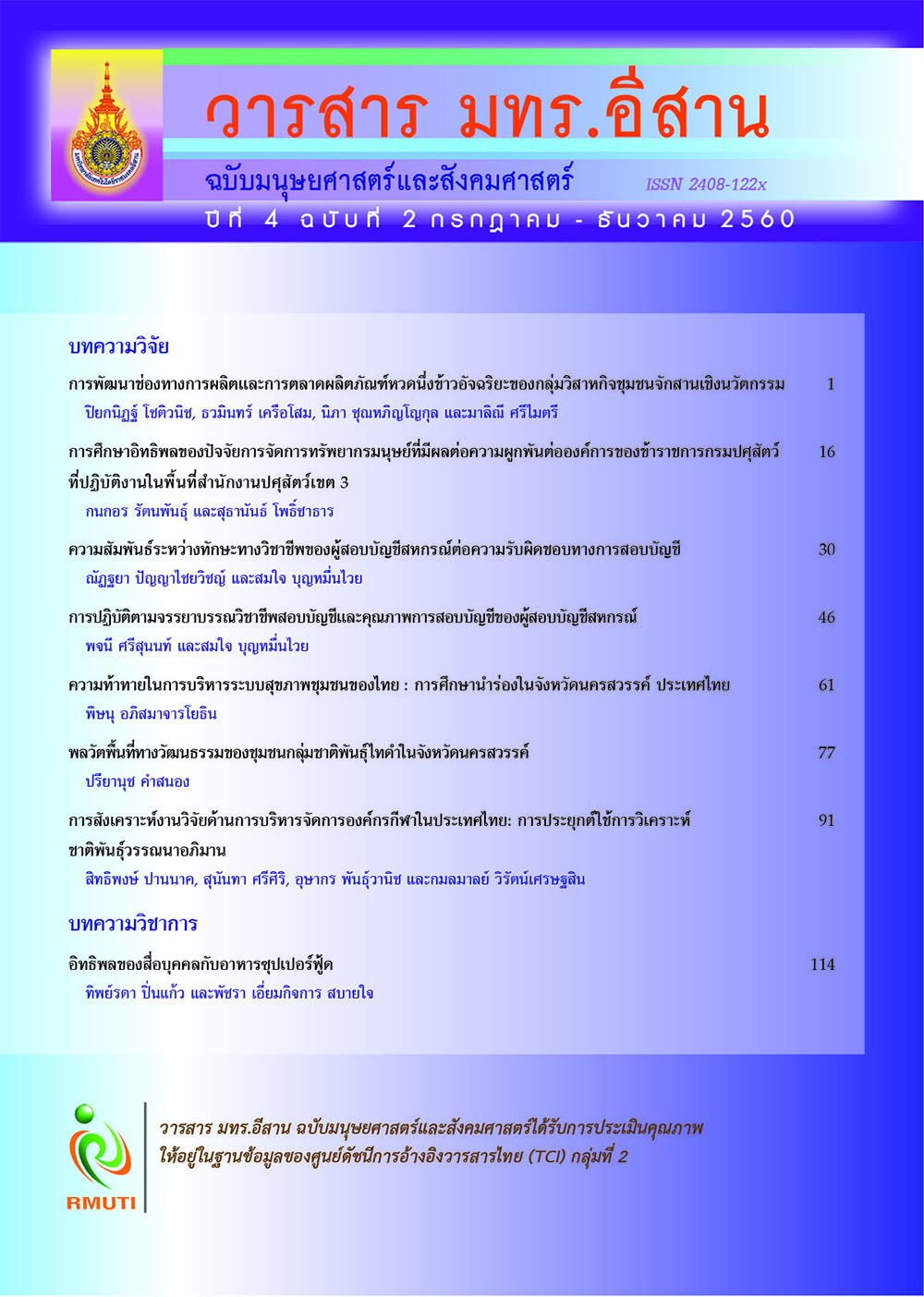Influence of Human Resource Management Factors Affecting Organizational Commitment of Government Officers Working in the Livestock Office of the Region 3, Thailand
Main Article Content
Abstract
This research aimed to study human resource management factors, the level of the organizational commitment, and the influence of human resource management factors affecting organizational commitment of government officers who work in the livestock office of region 3 in Thailand. The target population of this study was 607 government officers of department of livestock development who work in the livestock office of the region 3 covering 8 provinces: Nakhon Ratchasima, Chaiyaphom, Burirum, Surin, Yasothon, Amnat Charoen, Ubon Ratchathani and Srisaket, as of 26 December B.E.2558. The sample group was 241 government selected by Quota Sampling method. A set of questionnaire was employed as the tool in this study. Data were analyzed using frequency, percentage, mean, standard deviation, and stepwise multiple regression analysis. The results revealed that: Overall, the opinion regarding human resource management factors affecting the organizational commitment of the government officers was at high level. The aspect of Human Resource Development influenced the organizational commitment at the highest level and the aspect of Compensation and Welfare management, Human Resource Planning, Performance Appraisal, and Health and Safety, were respectively lower. Overall, the level of organizational commitment of the government officers was at high level. The aspect of Dedication expressed the organizational commitment at the highest level and the aspect of Organizational Loyalty, Work Values, and Job Satisfaction were respectively lower. Human resource management factors that affected the organizational commitment of the government officers, with statistical significance level of 0.05, were Performance Appraisal, Health and Safety, and Human Resource Development. 45.20 percent of these aspects were able to forecast the organizational commitment of the government officers.
Article Details
บทความที่ได้รับการตีพิมพ์เป็นลิขสิทธิ์ของมหาวิทยาลัยเทคโนโลยีราชมงคลอีสาน
ข้อความที่ปรากฏในบทความแต่ละเรื่องในวารสารวิชาการเล่มนี้เป็นความคิดเห็นส่วนตัวของผู้เขียนแต่ละท่านไม่เกี่ยวข้องกับมหาวิทยาลัยเทคโนโลยีราชมงคลอีสานและคณาจารย์ท่านอื่นๆในมหาวิทยาลัยฯ แต่อย่างใด ความรับผิดชอบองค์ประกอบทั้งหมดของบทความแต่ละเรื่องเป็นของผู้เขียนแต่ละท่าน หากมีความผิดพลาดใดๆ ผู้เขียนแต่ละท่านจะรับผิดชอบบทความของตนเองแต่ผู้เดียว
References
กัลยา วานิชบัญชา. (2554). การใช้ SPSS for Windows ในการวิเคราะห์ข้อมูล. กรุงเทพฯ : ศูนย์หนังสือแห่งจุฬาลงกรณ์มหาวิทยาลัย
เกียงศักดิ์ เขียวยิ่ง. (2550). การบริหารทรัพยากรมนุษย์. พิมพ์ครั้งที่ 5. สมุทรปราการ : โรงพิมพ์เดชกมลออฟเซท
คณะกรรมการพัฒนาการเศรษฐกิจและสังคมแห่งชาติ. (2558). แผนพัฒนาเศรษฐกิจและสังคมแห่งชาติฉบับที่ 11 (พ.ศ. 2555 - 2559). เข้าถึงเมื่อวันที่ (5 พฤษภาคม 2559). เข้าถึงได้จาก (https://www.nesdb.go.th/main.php?filename=develop_issue)
ณัฎฐพันธ์ เขจรนันทน์. (2556). การจัดการทรัพยากรมนุษย์. กรุงเทพฯ : เม็ดทราย พริ้นติ้ง
ณัฏฐพันธ์ เขจรนันทน์. (2551). พฤติกรรมองค์การ. กรุงเทพฯ : ซีเอ็ดยูเคชั่น
ธงชัย สมบูรณ์. (2549). การบริหารและจัดการทรัพยากรมนุษย์ในองค์การ. กรุงเทพฯ : ปราชญ์สยาม
บุญชม ศรีสะอาด. (2553). การวิจัยเบื้องต้น ฉบับปรับปรุงใหม่. พิมพ์ครั้งที่ 8. กรุงเทพฯ : สุวีริยาสาสน์
บัญญัติ มาศงามเมือง. (2551). ปัจจัยที่ส่งผลต่อการจัดการทรัพยากรมนุษย์ของโรงงานอุตสาหกรรมในจังหวัดหนองคาย. การค้นคว้าอิสระบริหารธุรกิจมหาบัณฑิต สาขาวิชาวิทยาการจัดการ มหาวิทยาลัยสุโขทัยธรรมาธิราช
ภรณี มหานนท์. (2543). การประเมินประสิทธิผลขององค์การ. กรุงเทพมหานคร : สำนักพิมพ์โอเดียนโสต์
วนิดา วาดีเจริญ, อธิวัฒน์ กาญจนวณิชย์กุล และสมบัติ ทีฆทรัพย์. (2556). การจัดการทรัพยากรมนุษย์จากแนวคิดทฤษฎีสู่ภาคปฏิบัติ. กรุงเทพฯ : วี พริ้นท์
วิลาวรรณ รพีพิศาล. (2550). การบริหารทรัพยากรมนุษย์ พิมพ์ครั้งที่ 2. กรุงเทพฯ : โรงพิมพ์วิจิตรหัตถกร
ศาวิตรี ธนกิจเจริญพัฒน์. (2557). อิทธิพลของการจัดการทรัพยากรมนุษย์ที่มีผลต่อความผูกพันของบุคลากรมหาวิทยาลัยรามคำแหง. วิทยานิพนธม์ หาบัณฑิต สาขาวิชาการจัดการทั่วไป มหาวิทยาลัยรามคำแหง
สมบุญ หลิมวัฒนา. (สัมภาษณ์). เมื่อ (5 พฤษภาคม 2559). ผู้อำนวยการสำนักงานปศุสัตว์เขต 3 ข้าราชการกรมปศุสัตว์ที่ปฏิบัติงานในพื้นที่สำนักงานปศุสัตว์เขต 3
อาทิตยา ลาภผลพูนทวี. (2553). ผลกระทบของประสิทธิภาพการบริหารทรัพยากรมนุษย์ที่มีผลต่อความผูกพันในองค์กรและเจตนาในการลาออกของพนักงานมหาวิทยาลัยมหาสารคาม. วิทยานิพนธ์บริหารธุรกิจมหาบัณฑิต สาขาวิชาการจัดการเชิงกลยุทธ์ มหาวิทยาลัยมหาสารคาม
Allen, N.Jl., and Meyer, J.P. (1990). The Measurement and Antecedents of Affective, Continuance and Normative Commitment to the Organization. Journal of Occupational Psychology. Vol. 63. Issue 1. pp. 1-18. DOI: 10.1111/j.2044-8325.1990.tb00506.x
Baron, R.A. and Greenberg, J. (1990). Behavior in Organization (3re ed.). Boston : Allyn and Bacon
Buchanan, Bruce, II. (1994). Building Organizational Commitment: The Socialization of Managers in Work Organizations. Administrative Science Quarterly. Vol. 19. No. 4. pp. 533-546
Cronbach, Lee J. (1974). Essentials of Psychological testing. 3rd ed. New York : McGraw-Hill
Durham, R.C., Murphy, T.J., Allen, T., Richard, K., Treliving, L., and Fenton, G.W. (1994). A Comparison of Cognitive Therapy, Analytical Psychotherapy and Anxiety Management Training in the Treatment of Generalized Anxiety Disorder. British Journal of Psychiatry. Vol. 165. No. 3. pp. 315-323
Kanter, Rosabeth M. (1968). Commitment and Social Organization : A study of Commitment Mechanim in Utopian Community. American Sociological Review. Vol. 33. No. 4. pp. 499-517
Miner, J.B. (1992). Industrial-Organization Psychology. New York : The State University of New York at Buffalo
Mondy, Wayne R., Robert M. Noe., and Shane R. Premeaux. (1999). Human Resource Management. 7th ed. New Jersey : Prentice - Hall International
Mondy, Wayne R., and Noe, Robert M. (1996). Human Resource Management. 6th ed. New Jersey : Prentice - Hall
Steers, R.M. (1977). Antecedents and Outcomes of Organization Commitment. Administrative Science Quartely. Vol. 22. No. 1. pp. 46-56
Yamane, T. (1973). Statistic : An Introduction Analysis. 2nd ed. New York : Harper and Raw


